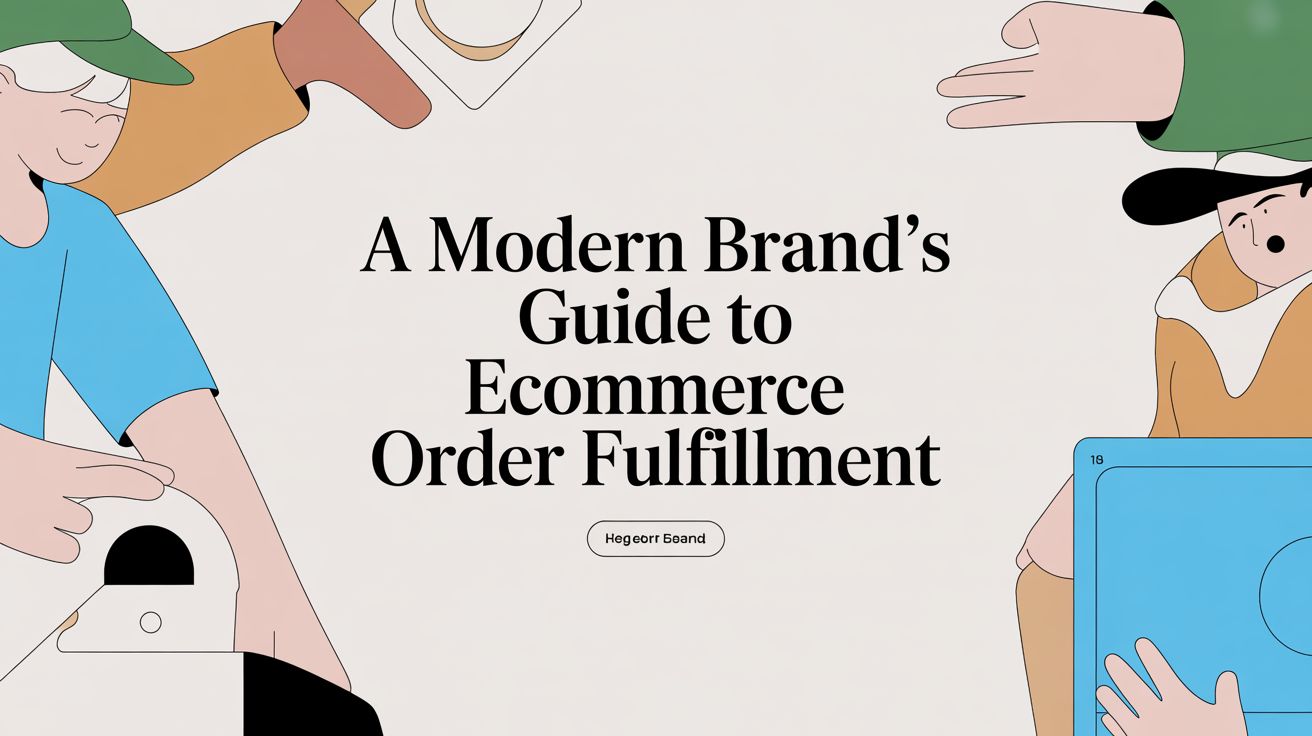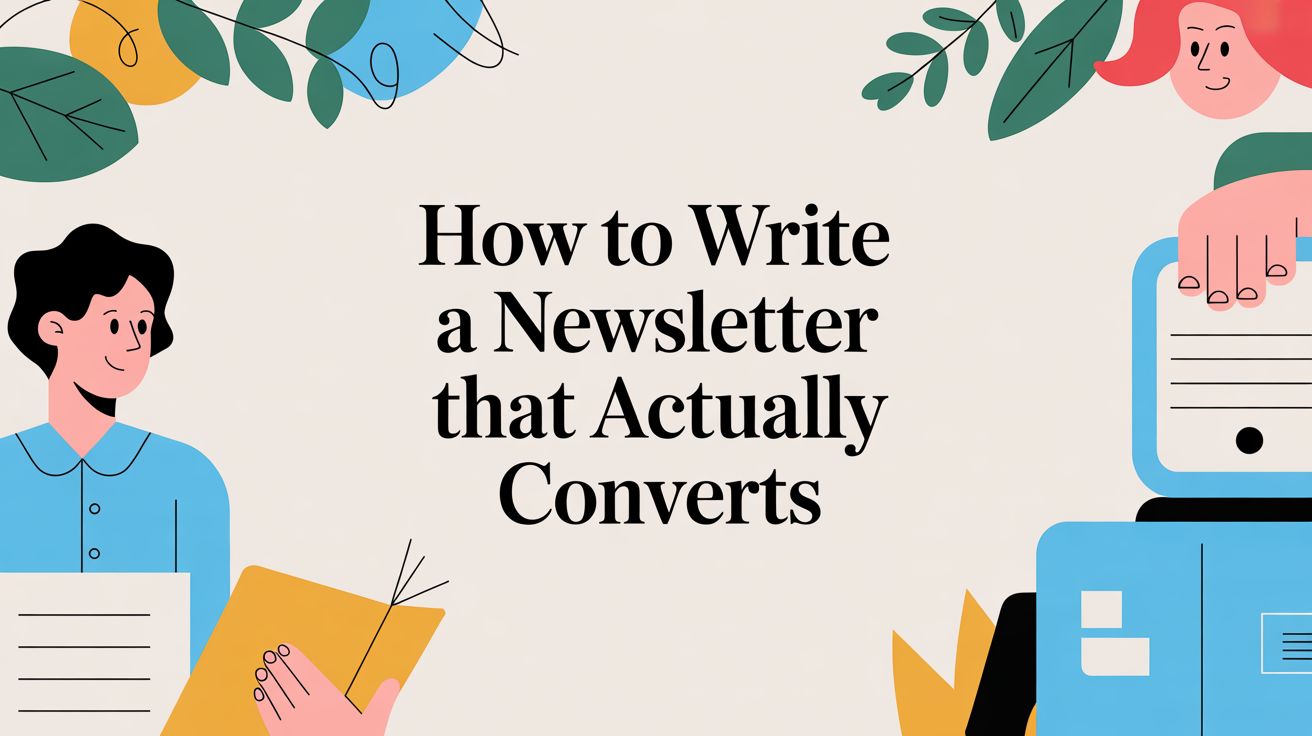
How to Build a Website That Converts: A Guide to Boosting Revenue & ROI
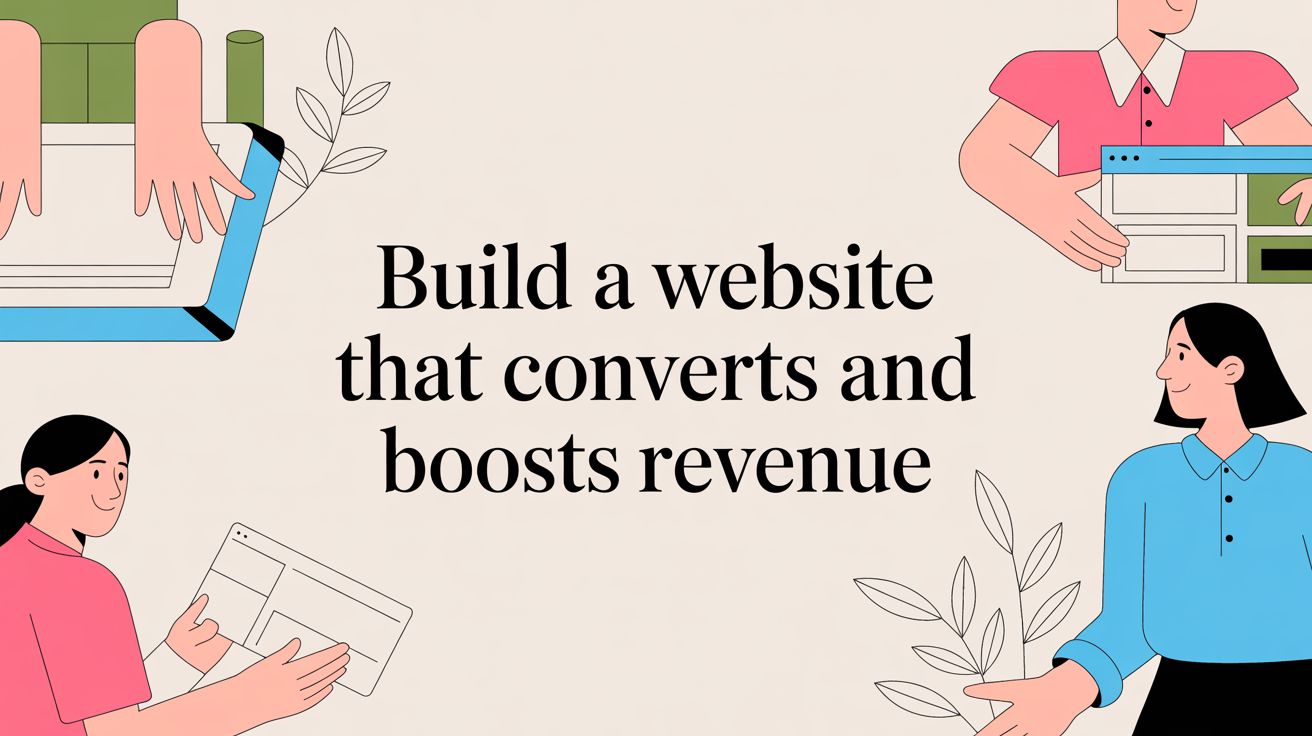
A website that converts is more than a digital storefront; it’s a finely tuned revenue engine. It skillfully guides visitors from browsing to buying by blending a seamless user experience with powerful psychological triggers grounded in behavioral science. While many brands focus on driving traffic, the most profitable ones build a user journey that turns clicks into revenue, moving beyond simplistic tactics like basic countdown timers.
Building a True Conversion Engine
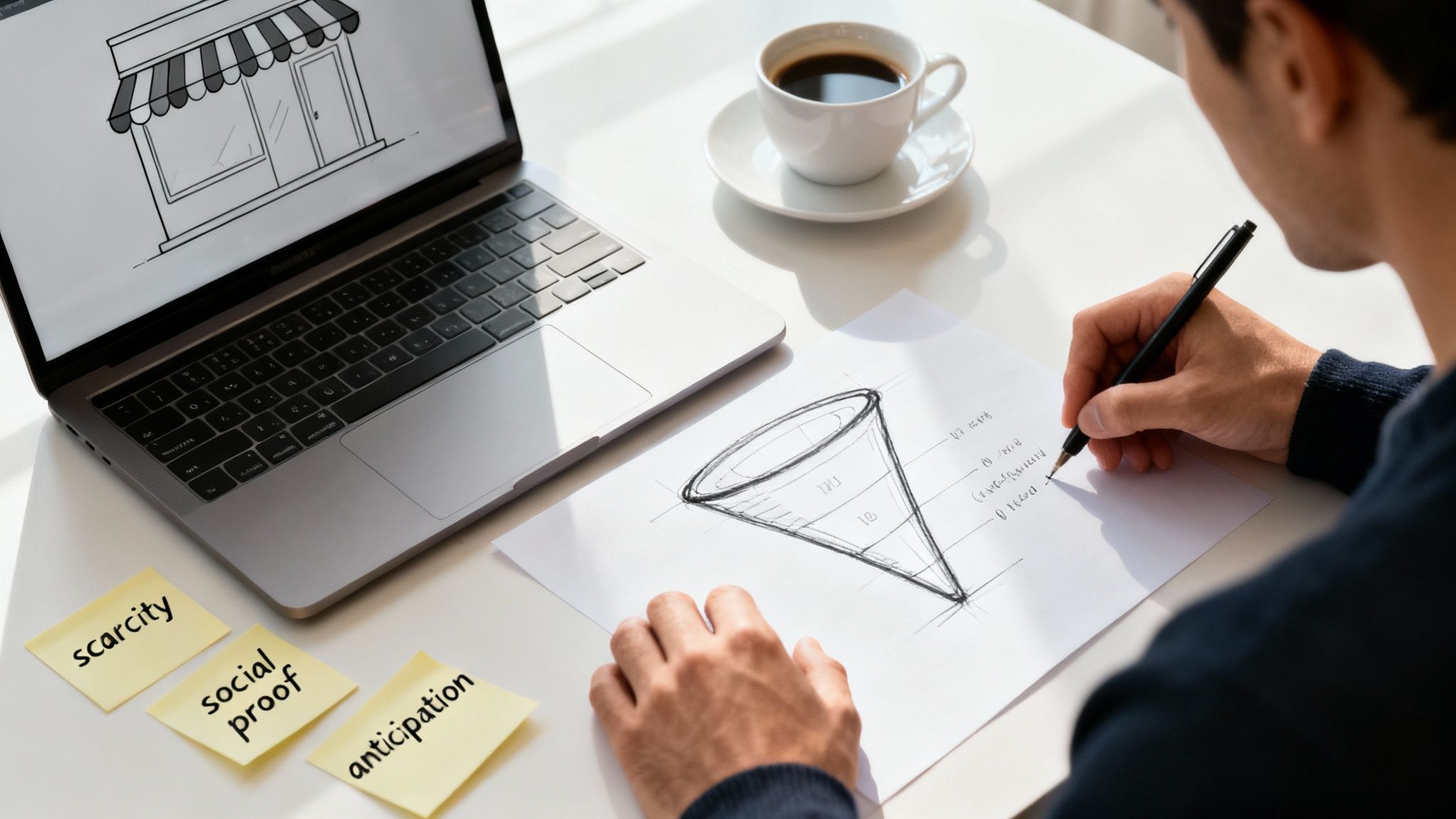
Creating a site that maximizes revenue requires a mental shift. Stop chasing vanity metrics and start applying the principles of consumer psychology. I’ve seen countless brands fixate on boosting their conversion rate without considering the quality of those conversions or the real impact on their bottom line and profit margins.
The primary goal is not just to sell more today. It's about crafting an experience that builds loyalty, protects your margins, and optimizes inventory management.
This guide breaks down the science behind high-performing sites, focusing on the sophisticated, psychology-driven strategies that create real, measurable business impact.
Understanding the Conversion Landscape
Let's ground this in data. The global average e-commerce conversion rate hovers around 2.5%. But that figure varies wildly by industry and is a crucial benchmark for performance.
For instance, the fashion and jewelry space averages a meager 1.9%, while electronics achieves a healthier 3.6%. Critically, while desktop users convert at 4.8%, mobile users—who make up 73% of all traffic—convert at only 2.9%.
This data highlights a massive opportunity. A generic, one-size-fits-all approach no longer works. To build a website that converts, you must design a journey that feels both exciting and effortless for the modern shopper.
A high-converting website doesn't just display products; it orchestrates a customer journey grounded in proven behavioral science. The focus shifts from simple transactions to building anticipation and validating the shopper’s choice at every single touchpoint.
Moving Beyond Basic Tactics
Generic pop-ups focused on email capture and endlessly looping countdown timers often fail because they feel inauthentic and don't tap into what truly motivates a customer. A genuinely effective strategy, like those powered by Quikly, weaves urgency marketing science into the fabric of the shopping experience to enhance banners, popups, and the entire shopper's journey.
This isn't about slapping a static "Sale" banner on your homepage. It's about replacing it with a dynamic announcement for a limited-time product drop or showing real-time demand right on the product page. This sophisticated approach drives revenue, not just email sign-ups.
Urgency Marketing Techniques Compared
Most brands stop at surface-level urgency, but the real ROI is generated when you apply deeper psychological triggers. Here’s how basic tactics stack up against sophisticated, revenue-focused strategies.
| Tactic Type | Basic Approach (e.g., Simple Popup Apps) | Advanced Strategy (e.g., Quikly Moments) |
|---|---|---|
| Countdown Timers | A generic site-wide banner that counts down to a vague "sale ending" time. | Product-specific timers tied to a cart reservation or a limited inventory release, grounded in real scarcity. |
| Social Proof | "20 people bought this" notifications that often feel disconnected or fake. | Displaying the number of real-time viewers on a product page or showcasing recent purchases with location data. |
| Limited Stock | A simple "Only 5 left!" message that stays the same for days. | A dynamic inventory counter that updates in real-time as items are added to carts and purchased, leveraging true scarcity. |
| Exclusive Offers | A generic "10% off your first order" popup shown to every visitor. | A tiered, gamified offer where faster responders get better rewards (e.g., first 100 get 30% off), driving immediate action. |
Advanced strategies create authentic, believable moments of urgency that feel native to the shopping experience, positioning urgency as sophisticated psychology, not manipulation.
Mastering these foundational elements is key. For a deeper dive into turning visitors into loyal customers, check out these proven strategies to increase website conversions. A clear, uncluttered user path is non-negotiable; every piece of friction you remove makes it easier for a shopper to click "buy."
Now, let's explore how to transform your Shopify store from a simple catalog into a powerful, revenue-generating engine built on the science of urgency.
The Psychology of Urgency in Conversion Optimization
To build a website that converts, you must understand the "why" behind every purchase. Many brands fail here. They apply a generic countdown timer and expect results, but it often falls flat because it lacks authentic psychological grounding.
True conversion optimization isn't about cheap tricks. It’s rooted in the science of behavioral economics—understanding what drives human action. It's about moving beyond manipulative tactics to create a shopping experience that feels genuinely compelling. This involves transparently communicating value in a way that connects with fundamental human drivers, guiding customers toward a purchase they feel great about.
The Power of Scarcity and Loss Aversion
A cornerstone of consumer psychology is the principle of scarcity. Behavioral economics research shows that when something is perceived as limited, its value increases in our minds. This taps directly into loss aversion—a cognitive bias where the pain of losing something feels psychologically twice as powerful as the pleasure of gaining it.
Instead of a vague "Sale Ends Soon!" banner, a sophisticated website uses authentic scarcity to create real urgency.
- Limited Stock: Showing real-time inventory counts like "Only 3 left in stock" gives shoppers a tangible reason to act now. It is infinitely more effective than a random timer because it’s tied to a real-world constraint.
- Exclusive Drops: Releasing a product in a limited quantity for a short window transforms a simple purchase into an event. This strategy drives immediate sales and builds long-term brand hype.
Actionable Takeaway: Connect your urgency tools directly to your Shopify inventory to display real-time stock levels on product pages. This is the most authentic way to leverage scarcity.
Building Trust with Social Proof
Humans are social creatures. We look to others for cues on how to behave, especially under uncertainty. This is the essence of social proof. A first-time visitor might be hesitant to buy, but seeing that others already trust you can dissolve that friction instantly.
Basic email pop-ups miss this opportunity. Advanced platforms weave in dynamic social proof that validates a shopper's interest in real time. The impact of seeing "27 people are viewing this item right now" or "Last purchased 15 minutes ago in New York" immediately confirms the product is in demand, making the purchase feel safer and more validated.
By signaling that an item is in high demand, social proof reduces decision anxiety. It transforms a solitary browsing session into a shared experience, subtly reassuring the customer that they are making a popular and wise choice.
Driving Action with FOMO and Anticipation
The Fear of Missing Out (FOMO) is a powerful motivator directly linked to scarcity and social proof. When a customer sees a limited-time offer that others are acting on, FOMO creates a strong impulse to join in. For a deeper dive, explore our guide on authentic Shopify urgency tactics.
Beyond the immediate, the principle of anticipation builds powerful emotional investment long before a product is available. Pre-launch campaigns, "coming soon" announcements, and exclusive waitlists build excitement and desire. By the time the product drops, customers aren't just buying an item; they're fulfilling an anticipation they've built for days. This turns a transaction into a memorable brand moment.
Integrating Urgency Triggers Across the Customer Journey
A website that converts doesn't just place an urgency tactic on a single product page. The real ROI comes from strategically weaving these psychological triggers into the entire shopping experience.
Moving from disjointed tactics to an integrated journey separates high-growth brands from the rest. The goal is to build a seamless flow, creating momentum from the first click to the final checkout confirmation. Forget generic "Sale" banners and basic email pop-ups; those are relics. Instead, picture a journey where every stage introduces an authentic reason to act now.
This flow maps the core psychological drivers—scarcity, social proof, and FOMO—across the customer's path to build conversion momentum.
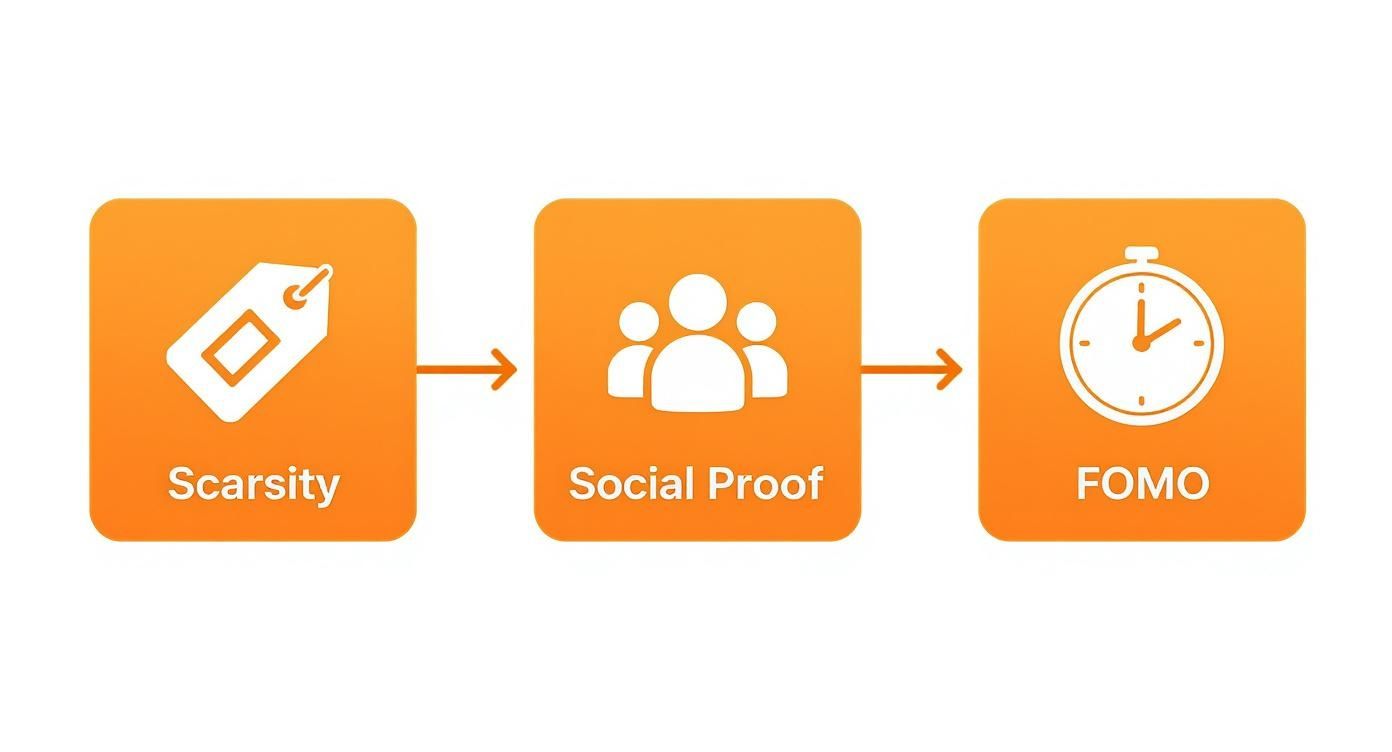
These aren't standalone tricks. They are a sequence of psychological nudges guiding a shopper from casual interest to a confident purchase.
Optimizing Each Stage of the Funnel
Here's how this looks in practice for a Shopify merchant aiming to boost revenue and customer experience.
Homepage Banners: Your homepage is your digital storefront. Don't waste it with a static "Shop Now" banner. Use it for dynamic announcements. Promote a limited-time product drop or a flash event that instantly communicates opportunity and turns passive browsing into active engagement.
Entry Popups: Most popups are a missed opportunity, focused solely on email capture. A smarter, revenue-first approach presents a time-sensitive incentive. Offer a first-time buyer 15% off, but only if they use it within the next 30 minutes. You capture the lead and drive an immediate purchase, directly impacting your bottom line.
Driving Action on Product and Cart Pages
The product and cart pages are where a sale is won or lost. This is your chance to combat hesitation with validation and a gentle, firm push.
Product Detail Page (PDP) Tactics
On the PDP, your main job is to eliminate decision anxiety. Integrate real-time social proof to validate the shopper’s interest.
Live Viewers: Showing "Currently being viewed by 25 others" signals popularity and creates a subtle sense of competition.
Low-Stock Alerts: Connect directly to your Shopify inventory to show authentic scarcity. "Only 4 left—order soon" is infinitely more powerful than a generic timer because it’s based on real data.
Industry benchmarks show a staggering 70% of shopping carts are abandoned, much of it from decision paralysis. By reserving a customer's items for a short period, say 10 minutes, you introduce the powerful principle of loss aversion. This simple shift changes their mindset from "Should I buy this?" to "I don't want to lose this."
The journey doesn't end when a visitor leaves. When you integrate these "Moments" with platforms like Klaviyo or SMS tools, you extend that urgency beyond your website. A well-timed email reminding a customer that a low-stock item is about to sell out is a powerful conversion trigger.
Customer Journey Touchpoint Optimization
This table breaks down actionable urgency tactics for each key point in the shopping experience to guide customers toward a purchase.
| Customer Journey Stage | Objective | Actionable Tactic Example |
|---|---|---|
| Discovery (Homepage/Landing Page) | Capture attention and drive initial engagement. | Use a dynamic banner to announce a "flash sale ending in 2 hours" or a limited-edition product drop. |
| Consideration (Product Page) | Reduce hesitation and build purchase confidence. | Display a "Low Stock: Only 3 left!" message based on real inventory, or show that "15 people bought this today." |
| Decision (Cart/Checkout) | Prevent abandonment and encourage completion. | Implement a cart reservation timer ("Your items are held for 10:00") to create a sense of ownership and loss aversion. |
| Post-Visit (Email/SMS) | Re-engage and recover potentially lost sales. | Send an automated alert: "The item you liked is almost gone!" when stock drops below a certain threshold. |
By architecting each stage, you create a cohesive and compelling experience that doesn't just ask for a sale, but actively earns it by tapping into genuine human psychology.
Why Site Performance Is Critical for Conversions
All the clever psychological triggers in the world are useless if your website is slow.
Nothing kills purchase excitement or shatters brand trust faster than a lagging page. What could have been a sale instantly becomes a frustrated bounce. Before a website can convert, it must perform.
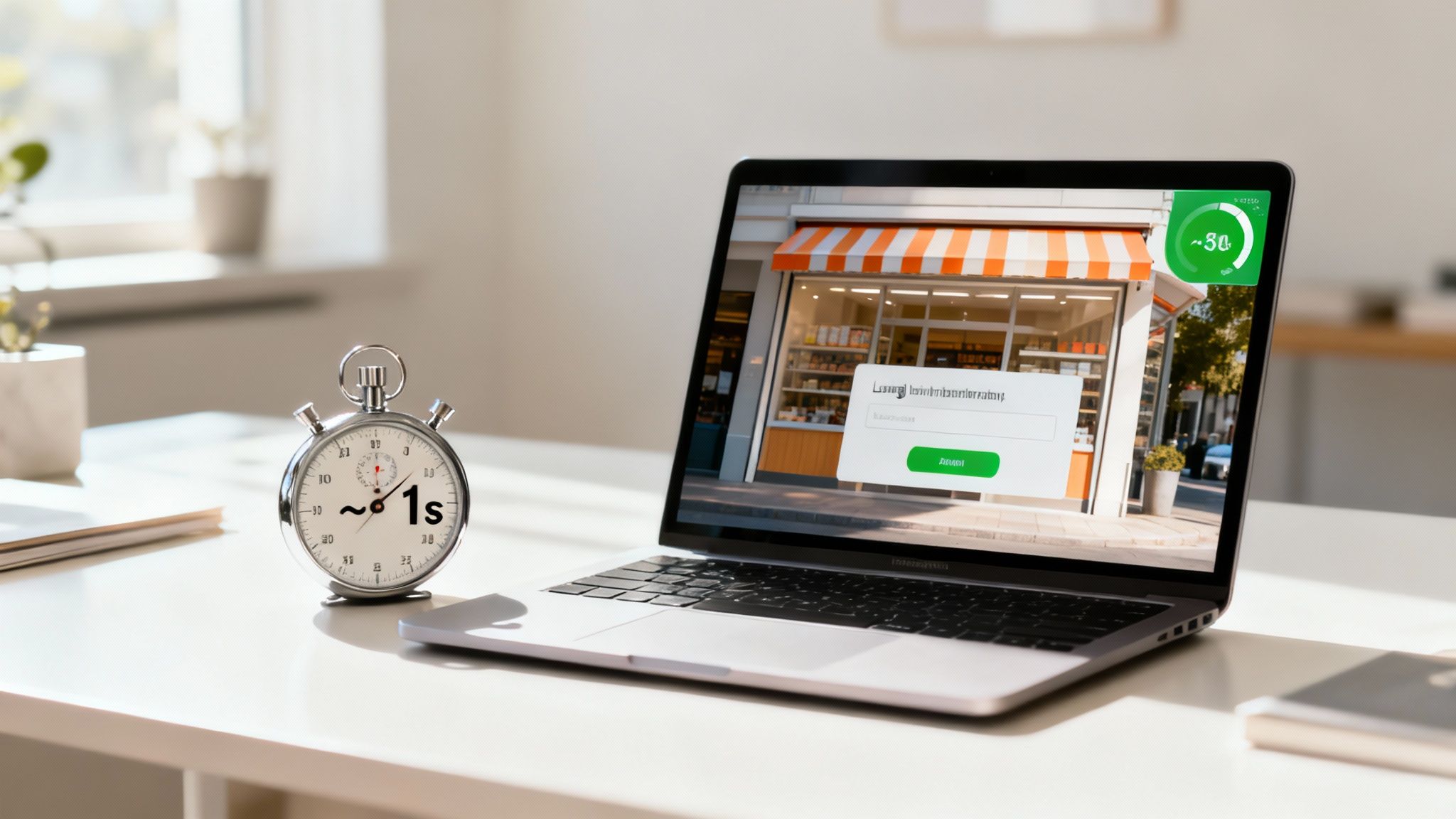
This is especially true for Shopify Plus merchants juggling huge product catalogs and high-traffic sales events. The gap between a one-second and a five-second load time is a direct hit to your revenue. For a deeper analysis, there's a great breakdown of why speed matters and how to fix a slow website.
The numbers are brutal. E-commerce sites loading in one second see conversion rates up to 2.5 times higher than sites that take five seconds. That skyrockets to five times higher compared to a site taking ten seconds to load. Every millisecond you shave off your load time pads your bottom line.
Auditing Your Site's Technical Health
Think of your website's performance as its foundation. If that foundation has cracks, everything you build on top is at risk. Start with a technical health audit.
Actionable Takeaway Checklist:
Tackle Your Images: Uncompressed images are often the main culprits of slow load times. Use tools to shrink file sizes without sacrificing quality and implement lazy loading so images below the fold only load as the user scrolls.
Cut the App Bloat: It's easy for Shopify merchants to pile on apps that inject heavy scripts. Be ruthless. Regularly audit your installed apps and remove anything that doesn't provide a clear ROI. Each one adds code that can slow your site down.
Put Browser Caching to Work: Caching lets you store parts of your site on a visitor's browser, so they don't have to reload everything on subsequent visits. This is a game-changer for speeding up the experience for returning customers.
A slow website doesn't just lose a sale; it creates a negative brand perception that can linger. Speed is a direct reflection of your brand's professionalism and respect for the customer's time.
The Mobile-First Imperative
With over 70% of e-commerce traffic coming from mobile, a clunky mobile experience isn't just an oversight—it's a liability. Yet, mobile conversion rates consistently trail desktop. The reason is simple: most sites aren't truly built for smaller screens and less reliable connections.
A seamless mobile journey is non-negotiable. This goes beyond responsive design; it demands a mobile-first mindset. Test your entire checkout flow on different phones. Are the buttons easy to tap? Are forms easy to fill out? Ironing out that friction on mobile is one of the fastest ways to close the conversion gap. For more advice, check out our guide on how to reduce bounce rate.
Measuring Success Beyond Conversion Rates
The true measure of a website that converts isn't just a climbing conversion rate—it's the tangible impact on your bottom line. A higher rate is a great headline, but it’s a vanity metric if it doesn’t translate into healthier profits and a more efficient business.
Focusing solely on the percentage of visitors who buy can be misleading. Did they buy full-price items, or only because of a deep, margin-killing discount? A well-executed urgency campaign doesn’t just sell more; it protects profitability. It’s a scalpel, not a sledgehammer.
Shifting Focus to Business-Critical KPIs
To see the full picture of your ROI, you need to track a more sophisticated set of metrics that reveal the true health and profitability of your ecommerce engine.
- Average Order Value (AOV): Are your urgency tactics encouraging customers to add more to their carts? A successful strategy should lift AOV, not just transaction volume.
- Customer Lifetime Value (LTV): Do customers acquired during limited-time drops stick around to buy again? This reveals if you're creating fleeting buyers or fostering brand loyalists.
- Profit Margin Protection: This is critical. Urgency creates sales velocity without resorting to deep, site-wide discounts that erode margins. This is a key lever for sustainable growth.
Analyzing these numbers draws a straight line from your marketing efforts to actual revenue and operational efficiency. That is a clear picture of success.
Proving ROI with Smart Testing
The best way to quantify the impact of advanced urgency is through structured testing. Don't just launch a campaign and hope for the best; measure and validate. For anyone on Shopify, this means getting comfortable with controlled experiments.
A/B testing is essential for proving value. Pit a sophisticated, automated urgency 'Moment'—like a tiered offer where the first 100 buyers get a better deal—against a basic, generic countdown timer. The goal is not just to see which one converts more, but which one generates more revenue and better protects your margins.
After a product drop, dive into cohort analysis. Track the LTV and repeat purchase rate of customers acquired during that event versus those from standard marketing channels. This data provides undeniable proof of the long-term value generated by psychology-driven campaigns. Finally, look at your inventory turnover. A powerful, often overlooked, benefit of urgency marketing is its ability to liquidate excess inventory without a fire sale.
Got Questions? We've Got Answers
Even with the best strategy, questions arise when implementing these psychological triggers. Here are some of the most common ones we hear from merchants.
Is Urgency Marketing Just a Gimmick?
This is a fair question. The answer is: it depends entirely on authenticity.
Urgency gets a bad rap from fake countdown timers that reset on refresh or bogus low-stock alerts. Those tricks destroy brand trust and poison customer relationships.
But when urgency is grounded in truth, it’s not manipulation. It’s effective communication.
- Real Scarcity: Showing there are only a handful of items left based on your actual Shopify inventory is simply being transparent.
- Genuine Social Proof: Displaying that 50 other people are viewing the same product is helpful context, not a trick.
- True Anticipation: Building buzz around a legitimate limited-edition drop is just good marketing.
Ethical urgency is about giving customers a clear, honest heads-up about a real opportunity, empowering them to make an informed decision.
How Can I Actually Do This on My Shopify Store?
Putting these ideas into practice is more straightforward than you think. You don’t need to be a developer or a psychologist. The key is to find a Shopify app designed specifically for behavioral marketing that goes beyond basic pop-ups.
Actionable Takeaway: Look for a tool that integrates directly with your product inventory for real-time stock counts. Ensure it integrates with your other platforms, like Klaviyo for email or your SMS provider, to create a seamless, cohesive customer journey. Start with one high-impact tactic, like a low-stock indicator on product pages. Measure its impact on add-to-cart rates, then build from there by adding a cart reservation timer next.
What's the Single Most Important Thing for a High-Converting Website?
There is no single silver bullet. A website that converts isn't the result of one magic feature; it’s about getting a handful of critical elements to work in harmony.
Think of it this way:
A truly high-converting website is an ecosystem, not a single feature. It is the synergy between customer insight, technical performance, and clear value communication that produces sustainable revenue growth and protects profit margins.
Everything rests on these three core pillars:
- Deep Customer Understanding: You must know what makes your audience tick—their fears, desires, and buying habits.
- A Flawless User Experience: Your site must be lightning-fast, intuitive, and trustworthy, especially on mobile where friction can kill a sale.
- Authentic Value Communication: Your message must be crystal clear, and any urgency you create must be 100% real. No exceptions.
When you focus on the whole picture—blending sharp marketing psychology with rock-solid technical execution—you build an engine that doesn't just chase clicks but reliably turns them into profit.
Ready to transform your Shopify store into a revenue-generating powerhouse? Discover how Quikly uses the science of urgency to create authentic, high-impact marketing moments that drive sales and protect your profits. Learn more and see it in action at https://hello.quikly.com.

The Quikly Content Team brings together urgency marketing experts, consumer psychologists, and data analysts who've helped power promotional campaigns since 2012. Drawing from our platform's 70M+ consumer interactions and thousands of successful campaigns, we share evidence-based insights that help brands create promotions that convert.
